| Article ID | Journal | Published Year | Pages | File Type |
|---|---|---|---|---|
| 624553 | Desalination | 2012 | 5 Pages |
An ultrasound-assisted emulsification microextraction procedure has been developed for determination of benzene, toluene, ethylbenzene and o-xylene (BTEXs) in water samples by gas chromatography–flame ionization detection system (GC–FID). The method is based on the dispersion of microvolumes of an organic solvent in the aqueous phase and subsequent extraction of target analytes into the fine droplets of the organic phase. After centrifugation, the sedimented phase is separated and directly injected to the GC system. The effects of experimental parameters such as type and volume of organic solvent, sonication and extraction times, salt effect and centrifugation time were evaluated and optimized. Under the optimum conditions a relatively broad dynamic linear range of 0.01–20 μg mL− 1 and a good linearity (R2) ranging from 0.9986 to 0.9998 were obtained for all the target analytes. The repeatability and reproducibility for 2 μg mL− 1 of each analyte (n = 5) were in the range of 1.58–5.75% and 2.54–5.89%, respectively. The limit of detection (S/N = 3) and preconcentration factor were in the range of 0.4–2 μg L− 1 and 653–835, respectively. Finally, the purposed method has been successfully applied to the determination of BTEX compounds in different water samples and good spiked recoveries over the range of 94–99% were obtained.
► Determination of BTEX compounds in water samples by gas chromatography. ► The ultrasound assisted emulsification is used for extraction of BTEX compounds. ► Ultrasound radiation has been used for induction of emulsification phenomena. ► Nitrobenzene is introduced as a good solvent for ultrasound assisted emulsification. ► Simplicity and high enrichment factor are the main advantages of proposed method.
